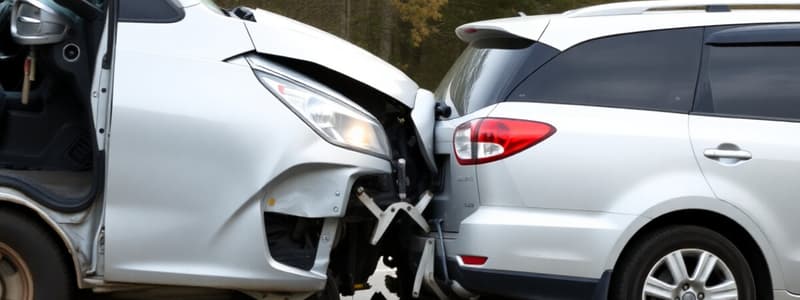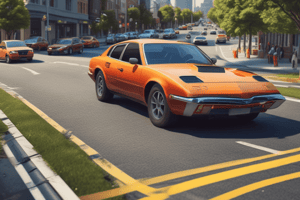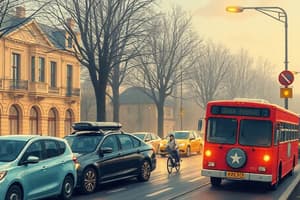Podcast
Questions and Answers
What is the purpose of opening a bodily injury (BI) claim?
What is the purpose of opening a bodily injury (BI) claim?
Why is a property damage (PD) claim opened after an accident?
Why is a property damage (PD) claim opened after an accident?
Who is an adjuster in the car insurance claim process?
Who is an adjuster in the car insurance claim process?
Why do we also open a claim with our client's insurance if the accident was not their fault?
Why do we also open a claim with our client's insurance if the accident was not their fault?
How do coverage limits impact a settlement?
How do coverage limits impact a settlement?
When would comprehensive insurance help our client?
When would comprehensive insurance help our client?
Why might a client receive a corticosteroid injection?
Why might a client receive a corticosteroid injection?
Why would an X-ray be ordered after a car accident?
Why would an X-ray be ordered after a car accident?
When might an MRI be necessary instead of an X-ray?
When might an MRI be necessary instead of an X-ray?
Why must the attorney approve imaging before it is scheduled?
Why must the attorney approve imaging before it is scheduled?
Which of the following steps comes first in the medical treatment journey after a very serious accident with serious injuries?
Which of the following steps comes first in the medical treatment journey after a very serious accident with serious injuries?
What is a common cause of rear-end collisions?
What is a common cause of rear-end collisions?
What often causes a side-impact accident?
What often causes a side-impact accident?
Who is usually at fault in head-on collisions?
Who is usually at fault in head-on collisions?
What is a common cause of single-vehicle accidents?
What is a common cause of single-vehicle accidents?
What makes determining fault in multi-vehicle pile-ups challenging?
What makes determining fault in multi-vehicle pile-ups challenging?
Who is usually at fault in a parking lot accident?
Who is usually at fault in a parking lot accident?
What is typically a cause of accidents involving bicycles or pedestrians?
What is typically a cause of accidents involving bicycles or pedestrians?
What is a common cause of side-swap accidents?
What is a common cause of side-swap accidents?
What system does California use to determine the level of responsibility in an accident?
What system does California use to determine the level of responsibility in an accident?
In California, if Driver A is 60% at fault and Driver B is 40% at fault, how is compensation affected?
In California, if Driver A is 60% at fault and Driver B is 40% at fault, how is compensation affected?
Who is typically at fault in a rear-end collision?
Who is typically at fault in a rear-end collision?
When might the front driver share responsibility in a rear-end collision?
When might the front driver share responsibility in a rear-end collision?
Which of the following is a common cause of head-on collisions?
Which of the following is a common cause of head-on collisions?
Which factor could shift some responsibility away from the driver in a single-vehicle accident?
Which factor could shift some responsibility away from the driver in a single-vehicle accident?
Why are multi-vehicle pile-ups more challenging to resolve?
Why are multi-vehicle pile-ups more challenging to resolve?
What often contributes to parking lot accidents?
What often contributes to parking lot accidents?
Who is usually at fault when a car hits a pedestrian legally crossing the street?
Who is usually at fault when a car hits a pedestrian legally crossing the street?
In a side-swap accident, who is typically responsible?
In a side-swap accident, who is typically responsible?
Who has the right-of-way when two cars arrive at a stop sign simultaneously?
Who has the right-of-way when two cars arrive at a stop sign simultaneously?
What does 'pure comparative fault' mean?
What does 'pure comparative fault' mean?
What type of insurance pays for injuries and damages caused to others if you are at fault in an accident?
What type of insurance pays for injuries and damages caused to others if you are at fault in an accident?
What does collision insurance cover?
What does collision insurance cover?
Comprehensive insurance provides coverage for:
Comprehensive insurance provides coverage for:
What does MedPay cover?
What does MedPay cover?
Why is uninsured/underinsured motorist coverage important?
Why is uninsured/underinsured motorist coverage important?
What does Personal Injury Protection (PIP) cover?
What does Personal Injury Protection (PIP) cover?
What are policy limits?
What are policy limits?
Which of the following is a common exclusion in car insurance policies?
Which of the following is a common exclusion in car insurance policies?
What is the purpose of a declarations page in a car insurance policy?
What is the purpose of a declarations page in a car insurance policy?
What is the main difference between lien doctors and non-lien doctors?
What is the main difference between lien doctors and non-lien doctors?
Why might a client choose to see a lien doctor after a car accident?
Why might a client choose to see a lien doctor after a car accident?
When might a client see a non-lien doctor instead of a lien doctor?
When might a client see a non-lien doctor instead of a lien doctor?
Which driver must yield at a four-way stop if they arrive at the same time?
Which driver must yield at a four-way stop if they arrive at the same time?
Which of the following would be considered distracted driving?
Which of the following would be considered distracted driving?
Which of the following is true regarding DUI laws?
Which of the following is true regarding DUI laws?
What should a driver do before changing lanes?
What should a driver do before changing lanes?
If a driver's brake light is not working and they are rear-ended, who might be at fault?
If a driver's brake light is not working and they are rear-ended, who might be at fault?
What evidence can help prove negligence in a car accident?
What evidence can help prove negligence in a car accident?
If a driver is 70% responsible for an accident, what compensation can they receive under California's pure comparative fault system?
If a driver is 70% responsible for an accident, what compensation can they receive under California's pure comparative fault system?
Study Notes
Rear-End Collisions
- Tailgating, or following too closely, is the most common cause of rear-end collisions.
- Rear-end collisions occur when the trailing driver cannot stop in time if the front vehicle stops abruptly.
Side-Impact (T-Bone) Accidents
- Side-impact accidents frequently occur when a driver fails to yield the right-of-way at intersections.
Head-On Collisions
- Responsibility for head-on collisions is often shared between both drivers, especially if one was driving in the wrong direction or performing an unsafe overtake.
Single-Vehicle Accidents
- Single-vehicle accidents are often caused by road hazards or vehicle malfunctions, such as brake failures or tire blowouts.
- Road hazards or dangerous conditions can reduce driver liability in single-vehicle accidents.
Multi-Vehicle Pile-Ups
- Determining fault in multi-vehicle pile-ups is difficult because multiple drivers may contribute to the collision sequence.
Parking Lot Accidents
- The driver leaving their parking space is typically at fault for parking lot collisions.
- Backing up without checking for obstacles or other vehicles is a common cause of parking lot accidents.
Bicycle and Pedestrian Accidents
- Distracted driving is a leading cause of accidents involving bicycles or pedestrians.
- Drivers are required to yield to legally crossing pedestrians.
Side-Swaps
- Side-swap accidents often occur when drivers fail to check their blind spots before changing lanes.
Determining Fault in California Car Accidents
- California uses a "pure comparative fault" system, where each driver is responsible for their share of the accident.
- Under pure comparative fault, each driver's percentage of fault determines their compensation.
Types of Car Insurance Coverage
- Liability insurance covers damages and injuries caused to others if you are found at fault in an accident.
- Collision insurance covers the repair or replacement of your car if it's damaged in an accident, regardless of who is at fault.
- Comprehensive insurance covers non-accident-related damages like theft, fire, vandalism, and natural disasters.
- MedPay covers medical bills for the insured driver and their passengers after an accident, regardless of fault.
- Uninsured/underinsured motorist coverage protects you if the other driver is uninsured or doesn't have enough insurance to pay for damages.
- PIP covers medical expenses, lost wages, and other costs, regardless of who is at fault in an accident.
Policy Limits
- Policy limits are the maximum amounts an insurance company will pay for each type of damage or injury covered by the policy.
Exclusions in Car Insurance Policies
- Insurance policies typically exclude coverage for intentional damage caused by the driver.
Declarations Page
- The declarations page details the types of coverage, policy limits, deductibles, and important information about the car insurance policy.
Lien Doctors vs. Non-Lien Doctors
- Lien doctors provide treatment without requiring immediate payment, with the promise of payment from any settlement.
- Non-lien doctors require payment upfront, either by cash, credit, or insurance.
Right-of-Way Laws
- When two vehicles arrive at a four-way stop at the same time, the driver on the right has the right-of-way.
Distracted Driving Laws
- Texting while driving takes the driver's attention away from the road, which is considered distracted driving.
DUI Laws
- A driver under the influence is typically found to be at fault if they cause an accident due to their impaired state.
Lane Usage and Change Laws
- A driver should always check their blind spots and use turn signals before changing lanes to ensure a safe maneuver.
Vehicle Equipment Laws
- If a driver's brake light is not working they may share fault with the driver behind if they are rear-ended.
Determining Fault
- Traffic laws, witness statements, photos, and police reports are crucial to proving negligence and determining fault in an accident.
Bodily Injury (BI) Claims
- A BI claim is opened to seek compensation for the costs associated with injuries resulting from a car accident.
Property Damage (PD) Claims
- A PD claim is opened to pay for repairs or replacement of the vehicle damaged in the accident.
Adjuster
- An adjuster is assigned by the insurance company to assess the accident, determine fault, and negotiate the settlement.
Why Open a Claim with Our Client's Insurance?
- Even if the accident was not their fault, we open a claim with our client's insurance to access MedPay and UM/UIM coverage.
MedPay and UM/UIM Coverage
- MedPay covers immediate medical expenses
- UM/UIM compensates if the at-fault driver has insufficient insurance
Coverage Limits
- Coverage limits set the maximum amount an insurance company will pay for a claim
Comprehensive Insurance
- Comprehensive insurance helps cover damage or loss not related to an accident such as theft, fire or vandalism
Corticosteroid Injections
- Corticosteroid injections are used to reduce inflammation and relieve pain
X-Rays
- X-rays are used to diagnose fractures and other injuries to the bones
MRI Use
- MRIs provide detailed images of soft tissues, such as muscles, ligaments, and discs
Approval of Imaging
- The attorney must approve imaging to ensure the cost will not exceed available coverage
Medical Treatment Journey
- Emergency care is the first step when a client is seriously injured
Studying That Suits You
Use AI to generate personalized quizzes and flashcards to suit your learning preferences.




